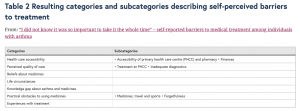BMC Pulmonary Medicine
Research article – Open Access – Open Peer Review
Tove Hedenrud, Annika Jakobsson, Hanan El Malla & Helle Håkonsen
BMC Pulmonary Medicine volume 19, Article number: 175 (2019)
Abstract
Background
Asthma is an extensive public health problem and inadequate disease control is not uncommon. Individuals’ self-perceived barriers to medical treatment for the entire treatment chain (from seeking care for symptoms to using a medicine) have seldom been studied for chronic diseases such as asthma. The aim of this study was to explore self-perceived barriers to medical treatment among individuals with asthma within the framework of AAAQ (availability, accessibility, acceptability and quality).
Methods
Individuals with asthma visiting the asthma nurse at a primary health care centre, and who currently had a prescription for anti-asthmatic medicines, were informed about the study. The nurse asked the persons for their consent to be contacted by an interviewer. The interview guide was constructed from the elements of AAAQ exploring self-perceived barriers to asthma treatment. Interviews were conducted in Swedish, English, Arabic and Persian. They were transcribed verbatim and a manifest content analysis was conducted.
Results
 Fourteen interviews were conducted. There was a large variation in both age and reported number of years with asthma. Self-perceived barriers to asthma treatment were experienced throughout the whole treatment chain. Barriers that emerged were health care accessibility, perceived quality of care, beliefs about medicines, life circumstances, knowledge gap about asthma and medicines, practical obstacles to using medicines, and experiences with treatment. The self-perceived barriers cover all four elements of AAAQ, but there are also some barriers that go beyond those elements (life circumstances and practical obstacles to using medicines).
Fourteen interviews were conducted. There was a large variation in both age and reported number of years with asthma. Self-perceived barriers to asthma treatment were experienced throughout the whole treatment chain. Barriers that emerged were health care accessibility, perceived quality of care, beliefs about medicines, life circumstances, knowledge gap about asthma and medicines, practical obstacles to using medicines, and experiences with treatment. The self-perceived barriers cover all four elements of AAAQ, but there are also some barriers that go beyond those elements (life circumstances and practical obstacles to using medicines).
Conclusions
Self-perceived barriers among individuals with asthma cover the whole treatment chain. We want to highlight the inadequate information/education of patients leading to knowledge gaps about both disease and the effect of medicines, and also the perceived unsatisfactory treatment at the PHCC, which could partly be counteracted if patients know what to expect from health care visits.
